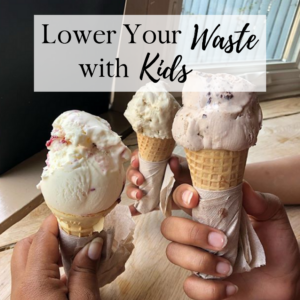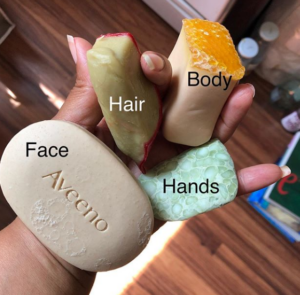This is a guest post from my friend Maranda Miller who has been sharing her transition to lowering her waste with two children on Instagram. I’ve received a lot of questions in the past asking how to transition to lower waste with a family. Since I started reducing my waste before having children, I’ve not had many tips for swaps with older children. So I asked my friend Maranda if she would share some of her experiences.
[line]
Before Plastic Became Bad My Mom would….
A few days ago me and my youngest were walking and she asked me to fix ramen for dinner (you know those $.20 packages). I said nope because none of the stores near us carry the noodles in a box. Frustration was immediately expressed in the statement, “Mom before plastic became bad, you would easily make it for us! Sometimes I wish we could go back to those days.”
My family has been on a plastic-free living mission for barely eight months. The first time I mentioned it to my children, they really didn’t pay me any mind. Luckily, a 60-Minutes special on the Great Pacific Garbage Patch aired within the same time. So we watched it together and that helped them to see the importance of us making changes in our purchases and day-to-day tasks. I started enhancing my own knowledge of things via social media and books (checked out from our local library). My awareness trickled down to them for I would bring it up in our discussions or as justification for things we would do.
Even though I initiated our journey, it is a joint effort. Typically, I do the research and figure out options for plastic-free alternatives, and then we discuss the best option as a family. I don’t have the luxury of just making swaps because I have older children (a teen and a tween). I don’t want to be the recipient of their wrath when a swap has been made over something they really like using. Disclaimer: Sometimes I do just make a swap for I will be the main one utilizing the item.
In my opinion, two key plastic-free swap categories parents should involve their children are toiletries and food. Everyone in the household has to eat and stay clean (at least to how each individual defines clean LOL).
 Plastic-free Swap: Toiletries
Plastic-free Swap: Toiletries
The easiest toiletry swap for our family was going to bar soap. My children get to select which soap they want (within limits since one has allergies) and it stays interesting since everyone wants a new variety each time. The hardest swap was going from single-use razors to a safety razor. Tons of aspects were taken into consideration when selecting our razor swap, especially ease of use for all parties. I can honestly say that involving my oldest in the decision was a wise move and we both like our final choice.
Plastic-free Swap: Food
Food is a touchy subject in our home – my children feel like sometimes I police what they can and can’t have based on the plastic packaging. It was easy for us to switch to beverages in glass and/or aluminum containers, but the retail price can restrict how much is bought. (Note: bonus of the swap is that everyone drinks more water now) Purchasing groceries is a great reminder that nobody is perfect and it is extremely hard to be completely plastic-free. I personally have a difficult time saying no to certain food requests because there aren’t better packaging alternatives nor do I have the time to cook/bake some things.
The transition to plastic-free living started as a way to ensure my children have a planet to grow old on, so it makes sense to include them in on our journey. Even though there are times they wish we went back to “before plastic was bad”, they realize the importance of reducing our plastic usage. Just so folks know, I did respond to my youngest’s rant on ramen. I explained that I would need to find a place that retailed the noodles in better packaging than what she was used to getting, or we could find a good ramen place to eat at (which we recently did the later).
How we approach the topic and talk to kids about plastic-free living is important. I have a different perspective since I have a teen and a tween whom at times get annoyed with mom 🙂
How to talk to older kids about reducing plastic:
- Make it personal – I try to show how the change is important for Mother Earth and for themselves. Like with our toiletries – they see how the swaps are also beneficial in their daily personal care.
- Make it relatable – Try to provide tiny nuggets of education rather than in-depth knowledge. I have learned that older children like the short-version so I might show them clips I’ve seen on social media/internet that would pique their interest.
- Make it their priority – Let them initiate the conversation and/or changes. For example, my youngest is the one that halted our purchase of the six-pack beverages since they had the plastic holders.
Maranda Miller, a Kentucky native, resides in the Bronx, NY with her two daughters (ages 9 and 14). Maranda loves being outdoors, doing yoga and works in higher education specializing in academic support and STEM education. The family started a zero waste and plastic-free journey in December 2018 to ensure that Mother Earth is around for them and future generations. Maranda has slowly begun sharing her eco-friendly habits with the Bronx community through work at the community garden, hosting a zero waste workshop, and starting a Buy Nothing Group for her neighborhood.
Learn more and follow along with Maranda @marandas_world


 Plastic-free Swap: Toiletries
Plastic-free Swap: Toiletries
Maranda Miller’s insightful post on plastic-free parenting for older kids is a beacon of hope in our journey towards eco-conscious living. It’s heartening to see how she blends practical advice with an empathetic understanding of the challenges faced by parents. The emphasis on eco-origin products is particularly commendable.
Using items like biodegradable utensils, organic cotton clothing, and sustainably sourced wooden toys can significantly reduce our environmental footprint. These products not only teach our children about the importance of respecting and preserving nature, but they also instill in them the values of responsible consumption from an early age. Furthermore, involving older kids in the decision-making process of selecting these products can empower them and enhance their environmental awareness.
Maranda’s approach is a reminder that every small step counts and that parenting can be a powerful platform for instilling eco-friendly habits. This post is a must-read for parents seeking to navigate the challenging but rewarding path of raising environmentally conscious children.